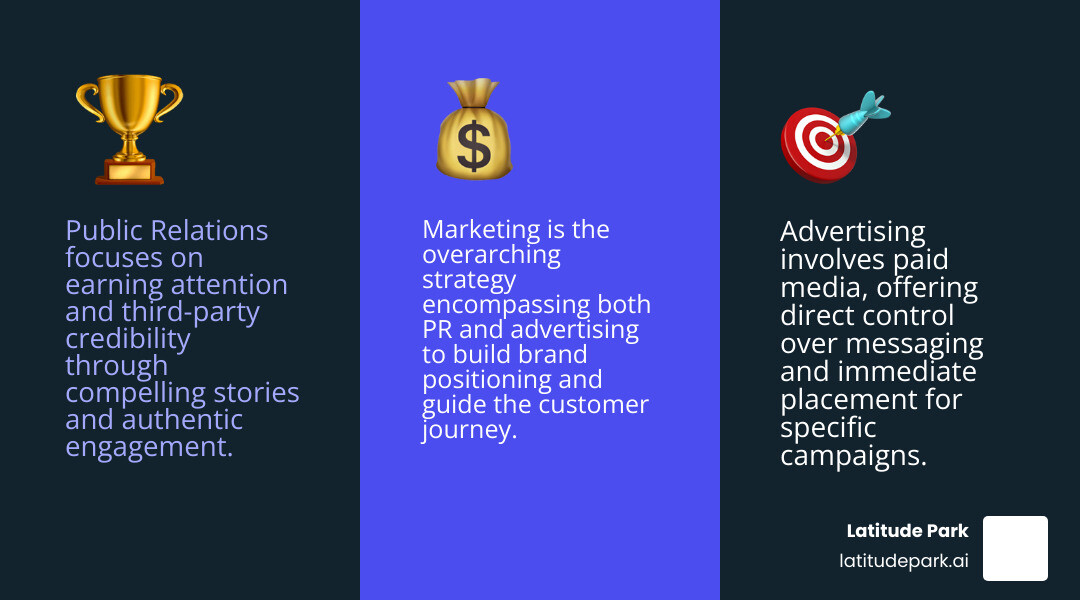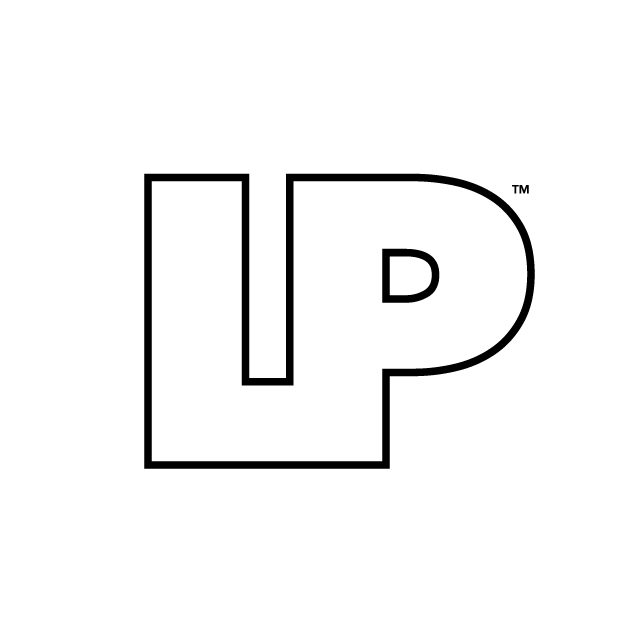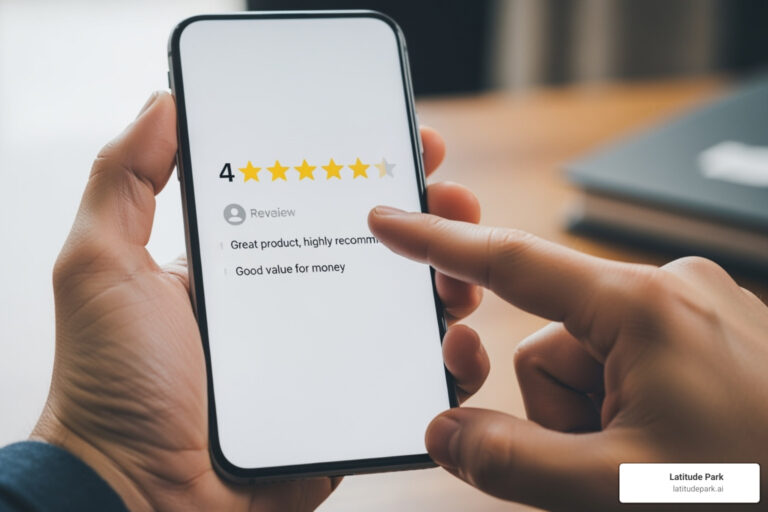Why Managing Public Relations Matters More Than Ever
Managing public relations is the strategic process of building and maintaining mutually beneficial relationships between organizations and their key stakeholders through consistent, authentic communication. Here’s what effective PR management involves:
Core Elements of PR Management:
- Strategic Planning – Developing written objectives, tactics, and timelines aligned with business goals
- Relationship Building – Engaging media, influencers, customers, and community members authentically
- Reputation Protection – Monitoring public perception and responding to crises proactively
- Measurement – Using analytics to track campaign performance and demonstrate ROI
- Multi-Channel Communication – Coordinating messaging across traditional media, social platforms, and digital channels
Think of PR as your organization’s reputation currency. According to industry research, the global public relations market is projected to reach $44.7 billion by 2030, growing at nearly 10% annually. Yet 45% of PR professionals still struggle to demonstrate value through measurement.
Unlike advertising (which you pay for), public relations earns attention through compelling stories, expert positioning, and authentic engagement. The return on PR typically outperforms paid advertising by creating third-party credibility that lasts far beyond a single campaign cycle.
Modern PR has evolved dramatically from simple press releases to encompass social media management, influencer partnerships, crisis communications, and data-driven strategy. Organizations now need professionals who understand both the art of storytelling and the science of analytics.
I’m Rusty Rich, founder and president of Latitude Park, where I’ve spent over 15 years helping businesses build strong public images through strategic digital marketing and communications. Throughout my career, managing public relations has been central to helping franchises and small businesses create consistent brand messaging that drives measurable growth.

The Foundations of Public Relations: Principles and Evolution

Public relations didn’t just appear overnight. It’s evolved from simple press stunts in the early 1900s to the sophisticated, data-driven practice we see today. Understanding this journey helps us appreciate why modern PR works the way it does.
When you’re managing public relations effectively, you’re working with principles that have stood the test of time. The foundation starts with building mutually beneficial relationships—not just broadcasting your message, but creating genuine connections where both your organization and your audiences actually benefit. This means listening as much as talking, adapting as much as advocating.
Strategic communication sits at the heart of good PR. Every press release, social media post, or media interview should connect back to specific business goals. We’re not just making noise; we’re being intentional about what we say and when we say it.
The early pioneers understood this instinctively. Edward Bernays, often called the “father of public relations,” saw PR professionals as applied social scientists who needed to understand public psychology to shape effective messages. Ivy Lee championed transparency and honest communication with the public, moving away from the sensationalism that had defined earlier publicity efforts.
The Public Relations Society of America has refined their official definition over decades. In 1982, they emphasized that “public relations helps an organization and its publics adapt mutually to each other.” Today, the PRSA defines PR as “a strategic communication process that builds mutually beneficial relationships between organizations and their publics.” That word “strategic” matters—it separates thoughtful PR from random publicity.
What is Public Relations Today?
Modern public relations looks quite different from what Bernays practiced a century ago. Today’s PR professionals are influencing stakeholders, shaping public perception, and building engagement across channels that didn’t exist even ten years ago.
The boundaries between PR and marketing have blurred considerably. PR teams now handle brand journalism, manage influencer relationships, and oversee community platforms. We’re crafting narratives, fostering genuine dialogue, and building trust through consistent, authentic communication.
A historical perspective on PR’s definition shows how the field has matured from simple press agentry to a discipline that requires business acumen, ethical judgment, and technological savvy. The core mission remains the same: help organizations communicate effectively with the people who matter most to their success.
The Four Models of Public Relations
Back in the 1980s, researchers James Grunig and Todd Hunt identified four distinct approaches to public relations that organizations use. These models help us understand not just how we communicate, but why we choose certain strategies over others.
| Model | Goal | Nature of Communication | Example |
|---|---|---|---|
| 1. Press Agentry/Publicity | Propaganda, gaining media attention | One-way; truth not essential; incomplete information | P.T. Barnum’s circus promotions, sensational celebrity news |
| 2. Public Information | Disseminate accurate information | One-way; truth important; complete information | Government reports, corporate press releases announcing facts, internal newsletters |
| 3. Two-Way Asymmetrical | Scientific persuasion, influence | Two-way; unbalanced effects; feedback used to persuade | Marketing research to tailor ad campaigns, political campaigns using polling data to craft messages |
| 4. Two-Way Symmetrical | Mutual understanding, dialogue | Two-way; balanced effects; negotiation; mutual adaptation | Community relations efforts, conflict resolution in organizations, open dialogues with stakeholders |
The first model, press agentry, is what most people think of when they hear “PR” in a negative context—think P.T. Barnum’s “there’s no such thing as bad publicity” approach. The public information model is more honest, focusing on distributing accurate information, though it’s still one-way communication.
Things get more interesting with the two-way asymmetrical model, where organizations gather feedback but primarily use it to craft more persuasive messages. The goal is still to change public opinion rather than adapt the organization itself.
The two-way symmetrical model represents the gold standard in modern PR. This approach treats communication as genuine dialogue, where both the organization and its publics are willing to change based on what they learn from each other. When you’re managing conflict or building long-term community relationships, this symmetrical approach creates sustainable results through negotiation, mediation, and mutual understanding.
Most successful organizations today blend these models depending on the situation, but the trend is clearly toward more dialogue and less monologue.
Building Your PR Toolkit: Essential Skills and Business Acumen
Here’s something I’ve learned over my years in this field: effective managing public relations isn’t just about crafting clever headlines or knowing how to write a press release. It’s about being a true strategic business partner who understands how communication drives real business results.
The most successful PR professionals I’ve worked with are the ones who can walk into a boardroom and speak fluently about quarterly projections, then turn around and write a compelling story that resonates with everyday people. They understand that business knowledge is just as important as communication skills. They grasp strategic planning, can steer financial statements, and know how to build a realistic budget that delivers measurable results.
This business acumen extends to understanding how PR supports critical functions like brand management and reputation building. When we develop PR strategies, we’re not working in isolation. We’re thinking about how our efforts contribute to lead generation, support the sales team, and ultimately impact ROI. We need to set clear objectives, track our progress, and demonstrate value in terms that business leaders understand.
A complete guide to PR services
Core Competencies for the Modern PR Professional
The PR landscape has evolved dramatically, and so have the skills we need to succeed. Let me walk you through the essential competencies that define excellence in modern public relations.
Strategic thinking sits at the foundation of everything we do. This means seeing beyond individual tactics to understand how each PR effort connects to broader business objectives. We develop comprehensive plans, anticipate challenges before they arise, and position our organizations for long-term success.
Compelling storytelling remains the heart of public relations. Whether we’re drafting a press release, creating social media content, or pitching a journalist, we need to craft narratives that genuinely connect with people. The best stories don’t just inform; they engage emotions and communicate value in ways that stick with audiences long after they’ve finished reading.
Data analysis has become non-negotiable in today’s PR environment. We’re constantly measuring campaign metrics, tracking sentiment shifts, and mining insights from analytics dashboards. This data doesn’t just help us report on what happened; it guides our future strategies and helps us demonstrate concrete ROI to stakeholders.
Social media savviness goes far beyond knowing how to post on Facebook or Instagram. We need to understand platform algorithms, manage online communities effectively, vet potential influencer partners, and steer the nuances of each channel. With 65% of organizations increasing their digital investment, this expertise has moved from nice-to-have to essential.
Crisis management aptitude can make or break an organization’s reputation. We develop proactive crisis communication plans before problems emerge, and when issues do arise, we execute reactive strategies with transparency and speed. The fact that only 55% of organizations have a crisis plan in place tells me there’s still significant work to be done in this area.
Ethical judgment underpins everything we do. Our credibility depends on acting with integrity, navigating legal considerations like defamation and copyright issues, and adhering to professional standards like the PRSA Code of Ethics. Without ethics, we have nothing.
Finally, diversity, inclusion, equity, and access awareness shapes how we approach modern communications. We ensure our messaging reflects diverse audiences, our practices are equitable, and our teams feel a sense of belonging whether they’re working in an office or remotely.
Aligning PR with Business Objectives
I’m often asked: “How does PR actually move the needle on business goals?” It’s a fair question, and one that deserves a clear answer.
Public relations directly supports brand management by defining and maintaining a consistent brand identity across all touchpoints. Through strategic messaging and positive media coverage, we shape how target audiences perceive an organization, building the trust and loyalty that translate into customer retention and advocacy.
Reputation building creates tangible business value. A strong reputation attracts customers, appeals to investors, and helps recruit top talent. It’s an asset that compounds over time, making every subsequent marketing effort more effective.
When it comes to lead generation and supporting sales, PR works differently than direct advertising, but often more powerfully. Positive media mentions, thought leadership content, and authentic community engagement create awareness and credibility that influence purchase decisions throughout the sales funnel. As we’ve seen in our work at Latitude Park, this third-party validation often delivers better returns than paid advertising because people trust earned media more than promotional messages.
The contribution to ROI remains a challenge for many in our field. Research shows that 45% of PR professionals struggle with ROI measurement, but I believe this is exactly where we need to focus our efforts. By setting clear objectives upfront and tracking relevant metrics like media sentiment, website traffic from PR sources, and conversion rates, we can demonstrate concrete value.
Setting objectives and budgeting brings everything together. We articulate PR objectives in writing, review past performance to understand what worked, brainstorm new tactics, and allocate resources strategically. This disciplined approach transforms PR from a “nice to have” into a core business function that drives measurable growth.
At Latitude Park, we’ve applied these principles to help franchise businesses build consistent brand messaging that supports their growth objectives. The same strategic thinking that guides our franchise marketing work applies to effective managing public relations across any industry.
Modernizing Your Approach to Managing Public Relations

The world of managing public relations looks completely different than it did just a decade ago. If you’re still relying solely on traditional media outreach and quarterly press releases, you’re missing out on powerful opportunities to connect with your audiences where they actually spend their time.
Today’s PR professionals need to be comfortable juggling social media management, content creation, influencer partnerships, and real-time engagement alongside traditional media relations. It’s a lot, but the payoff is enormous when you get it right.
The Role of Technology and Analytics
Technology has fundamentally changed how we do our jobs in PR. Gone are the days when you could send out a press release and hope for the best. Now we have digital tools that let us track every mention, measure every engagement, and understand exactly how our messages resonate.
Social listening platforms have become essential for monitoring conversations about our brands in real time. These tools help us spot emerging trends, identify potential issues before they become crises, and understand what our audiences truly care about. We’re not just broadcasting messages anymore; we’re participating in ongoing conversations.
The intersection of SEO and PR has created exciting new opportunities. When we optimize our press releases and content for search engines, we extend their reach far beyond traditional media outlets. A well-optimized piece of content can continue driving value for months or even years after publication.
Here’s where things get interesting: measuring ROI remains one of the biggest challenges in PR. About 45% of professionals struggle to demonstrate clear value from their efforts. But the tide is turning. With the right analytics tools, we can track everything from media mentions and website traffic to social engagement and actual conversions tied to PR campaigns.
The good news? About 65% of PR professionals are planning to increase their investment in digital PR areas like social media and online content. This tells us the industry recognizes where the future is headed. At Latitude Park, we’ve seen how data-driven PR strategies deliver results that far exceed traditional advertising approaches, especially when it comes to building lasting credibility.
Crisis Communication in the Digital Age
Let’s talk about something that keeps PR professionals up at night: crisis management. In our hyperconnected world, a single misstep can go viral in minutes. The speed at which information spreads today makes proactive crisis planning absolutely essential.
About 55% of organizations now have a formal crisis communication plan in place. If you’re in the other 45%, it’s time to change that. A solid crisis plan identifies potential vulnerabilities, designates clear spokespersons, and outlines specific communication protocols. Think of it as insurance you hope you’ll never need but are grateful to have when things go sideways.
When crisis strikes, transparency and timeliness become your best friends. The post-pandemic era has taught us that audiences value honest, data-driven communication over polished corporate-speak. People can smell insincerity from a mile away, and a tone-deaf response can turn a small problem into a full-blown disaster.
Reputation protection during a crisis requires a delicate balance. You need to acknowledge the problem, show genuine empathy, and outline concrete steps you’re taking to address it. Sometimes this involves dialogue and negotiation with affected parties. Other times, it means using mediation or other conflict resolution tools to find mutually agreeable solutions.
The digital age has also given us new tools for turning crises into opportunities. Remember Taco Bell’s brilliant “Thank You for Suing Us” campaign? They transformed a potential PR nightmare into a moment that strengthened customer loyalty. While we can’t promise every crisis can become a victory, approaching challenges with authenticity and creativity often leads to surprisingly positive outcomes.
The key to modern crisis communication is staying nimble, staying honest, and staying connected to your audiences through every available channel.
Navigating the PR Structure: Ethics, Legality, and Teams
When it comes to managing public relations, the decisions you make about structure, ethics, and team composition will shape everything that follows. These aren’t just administrative details. They’re the foundation that determines whether your PR efforts build trust or erode it, whether they protect your reputation or put it at risk.
Ethical Considerations and Legal Aspects
Let’s be honest: in public relations, your credibility is everything. Without it, you’re just noise. That’s why ethical conduct isn’t optional or something you tack on at the end. It’s woven into every press release, every media pitch, every social post you craft.
The Public Relations Society of America offers a comprehensive code of ethics that covers the principles we should all live by: honesty, advocacy, expertise, independence, loyalty, and fairness. These aren’t abstract concepts. They mean telling the truth even when it’s uncomfortable, representing your organization faithfully without misleading the public, and maintaining independence of judgment.
On the legal side, managing public relations means navigating some complex territory. Defamation laws protect individuals and organizations from false statements that harm their reputation, so every claim we make needs to be verifiable. Copyright law means we respect intellectual property, whether that’s using images properly or quoting sources correctly. When working with influencers, we need to ensure they disclose partnerships according to Federal Trade Commission guidelines.
Privacy regulations have become increasingly important too. We handle sensitive information regularly, and protecting it isn’t just good practice. It’s the law. Professionalism, ethics, and legal compliance form an inseparable trio that supports everything else we do in public relations.
Key Considerations for Managing Public Relations In-House vs. Agency
One of the biggest questions organizations face is whether to build an internal PR team or partner with an external agency. I’ve seen both models work beautifully, and I’ve seen both fail spectacularly. The difference usually comes down to understanding what you actually need.
In-house teams bring deep brand knowledge that’s hard to replicate. When your PR professionals work alongside your product team, your sales staff, and your leadership every day, they develop an intuitive understanding of what makes your organization tick. They know the unwritten rules, the company history, and the subtle nuances of your brand voice. This seamless integration means faster decision-making and tighter alignment with other departments.
From a financial perspective, in-house teams often provide better cost control for ongoing needs. If you have consistent, predictable PR requirements, paying salaries can be more economical than agency retainers. Plus, your team’s dedicated focus stays entirely on your organization, not split among multiple clients.
The trade-off? In-house teams sometimes develop tunnel vision. When you’re immersed in one organization, it’s harder to see it objectively or bring fresh ideas from outside your industry. Your network of media contacts and influencers might be narrower too. And building a skilled team requires significant investment in recruitment, salaries, benefits, and ongoing professional development.
External agencies shine in different ways. They bring specialized expertise across various PR disciplines. Need crisis communications one month and influencer outreach the next? An agency likely has specialists for both. Their broader networks include extensive media contacts and industry connections. Organizations like the PR Council represent global, midsize, regional, and specialty firms with reach that would take years to build independently.
That fresh perspective is invaluable too. An agency sees your organization through your audience’s eyes, not filtered through internal politics or assumptions. They bring ideas from other industries and clients, sparking innovation you might not generate internally. And agencies offer scalability, ramping up for major campaigns or scaling back during quieter periods without the commitment of full-time employees.
The downsides? Agency fees add up quickly, especially on retainer models. You’re also entrusting your public image to people outside your organization, which requires strong communication and oversight. There’s always a learning curve as agencies get up to speed on your brand, industry, and internal dynamics.
Many successful organizations actually use a hybrid approach, handling day-to-day PR internally while bringing in agency partners for specialized projects, crisis management, or when they need extra capacity. At Latitude Park, we’ve seen franchise clients benefit from this model, managing local PR in-house while partnering with specialists for regional or national campaigns.
Core Principles for Effectively Managing Public Relations
Whether you choose in-house, agency, or hybrid, certain principles remain constant. Client-centered communication means every message is crafted with specific audiences in mind. We’re not broadcasting into the void. We’re speaking directly to people who have particular needs, concerns, and preferred ways of receiving information.
Professionalism and ethical conduct aren’t negotiable. We maintain the highest standards in every interaction, adhering to both ethical guidelines and legal requirements. This protects not just our clients but the entire profession.
Diversity, inclusion, equity, and access have moved from nice-to-have to essential. Modern PR must represent diverse voices and perspectives authentically. This is especially critical when managing remote teams, where creating an equitable and accessible environment requires intentional effort. We can’t claim to understand public perception if we’re only listening to a narrow slice of the public.
Strategic alignment ensures every PR decision supports broader organizational goals. We’re not doing PR for PR’s sake. We’re contributing to business objectives in measurable ways, whether that’s building brand awareness, supporting sales, or protecting reputation.
Finally, continuous evaluation and adaptation keeps us relevant. The PR landscape shifts constantly. What worked last year might fall flat today. We research, conduct campaigns, measure results, gather feedback, and adapt. This ongoing cycle of planning, execution, and measurement ensures our efforts remain effective and our strategies stay fresh.
Managing public relations effectively means getting all these pieces right: the ethical foundation, the team structure that fits your needs, and the principles that guide daily decisions. Get these fundamentals solid, and everything else becomes easier.
Conclusion: Mastering Your Public Image
We’ve walked through managing public relations, tracing its path from the press agentry days of P.T. Barnum to today’s data-driven, digitally-connected landscape. Along the way, we’ve found that effective PR isn’t about spinning stories or manipulating perception—it’s about building genuine, mutually beneficial relationships through strategic, ethical communication.
The journey has shown us that modern PR professionals need to be part storyteller, part analyst, part crisis manager, and part business strategist. We’ve explored the four foundational models of public relations, emphasizing how the two-way symmetrical approach creates real dialogue and understanding. We’ve examined the essential skills that separate good PR from great PR: strategic thinking, compelling storytelling, data analysis, social media savviness, crisis management aptitude, and unwavering ethical judgment.
We’ve also seen how technology has revolutionized our field. With 65% of PR professionals increasing their digital investment and 55% of organizations maintaining formal crisis plans, it’s clear that the profession is evolving rapidly. Yet the core principles remain unchanged: transparency, authenticity, and strategic alignment with business objectives.
For organizations navigating today’s complex communication landscape—especially multi-location franchises like those we work with at Latitude Park—mastering your public image isn’t optional. It’s essential. Your reputation influences everything from customer trust to employee retention to long-term growth potential. The return on PR consistently outperforms paid advertising because earned media carries third-party credibility that money simply can’t buy.
Whether you choose to manage PR in-house with deep brand knowledge and seamless integration, or partner with an agency for specialized expertise and broader networks, the key is commitment to the continuous process. Public relations isn’t a one-time campaign or a quick fix. It’s an ongoing conversation with your stakeholders, requiring constant listening, adapting, and authentic engagement.
At Latitude Park, we understand that targeted, strategic communication builds strong brands. Our expertise in franchise marketing has taught us that consistency across multiple locations, combined with localized engagement, creates powerful brand presence. The same principles that drive our Meta advertising strategies—understanding audiences, crafting compelling messages, and measuring results—apply directly to managing public relations effectively.
Your public image is ultimately shaped by every interaction, every message, and every decision your organization makes. By applying the strategic playbook we’ve outlined here, you can take control of your narrative, build lasting relationships with your stakeholders, and create a reputation that drives real business results.
Take control of your narrative with a strategic PR Press Release Service










